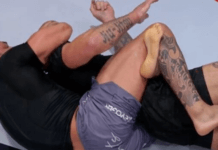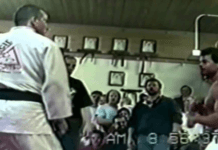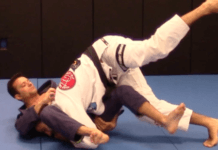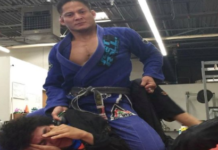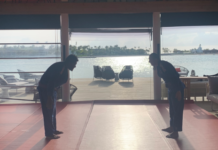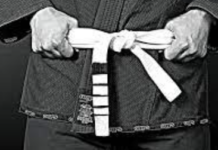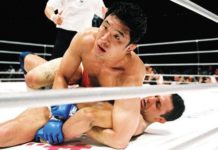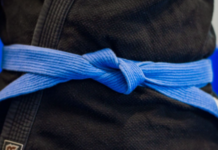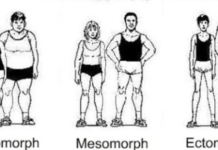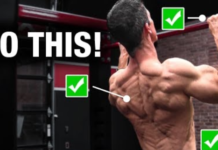In BJJ, the mobility of the hips is extremely important. As is commonly stated, yoga and dynamic stretching are very helpful in this area. However, few of us have time for an additional unit of training per week in the form of separate yoga classes. So the introduction of several exercises to improve hip mobility for warming up or post-workout stretching is a good solution.
Hip Mobility for BJJ
Why hip mobility is important?
The first months on the mat and learning basic exercises can be a nightmare if you got limited hip mobility. In this case, the fight from below is totally out of the question, and the only reasonable positions to learn are closed and half-guard. With mobility restrictions, learning De La Riva, spider or butterfly guard is simply a waste of time. Therefore, working on hip mobility is a very important aspect in the development of technical skills. Furthermore, fighting with a guard is really just a skillful control of the opponent’s hips based on distance or clinching. Stretched hips also mean injury prevention.
So how should we work on the mobility of our hip? Below are examples of exercises thanks to which we gonna stretch our hips.
Hip Mobility Best exercises and stretches
The Shinbox
One of the best ways to mobilize our hips is the exercise so-called “The shinbox”. The movement itself significantly improves the functionality of the hips, increasing the range of their mobility. The advantage is that “the shinbox” also helps to find movement deficiencies in the knee joints, spine, pelvis itself, or shoulders. And doing the exercise increases mobility in all of these segments.
To properly perform this exercise, we must begin with basic movements that will prepare our body to perform shinbox later. This is the position where most of the training people, not mobilizing before, will spend a lot of time to get the body in order. Movements should be smooth enough to prevent excessive muscle strain where the body will fight against tensile resistance. We must also remember to use breathing techniques that will allow us to relax the muscle more effectively. The main thing is to deepen the movement with the exhalation and breathe in when we return to the starting position.
When the position will cause a problem, we do not use the arms to start, and the movement is made only by the turns of the torso. For advanced people, however, you can enter resistance rubbers or ball weights. However, before you master the basic technique fully, using the obstacle will be a huge mistake.
Goblet squat
This exercise increases the range of our hip motion. In addition, you can deepen your squat or stop in the lower position for a few seconds to feel the stretching even more.
Starting position:
– Stand up straight, look straight ahead
– Legs slightly apart, shoulder-width apart, and toes pointing outward
– Push the chest forward, remove the shoulder blades, tighten the stomach and buttocks
Movement:
– Inhaling the air and keeping the starting position (straight back) do a smooth squat, trying to go as low as possible (below the right angle)
– Return to the starting position with the exhalation (note: do not knee open!)
The most common mistakes in technique:
- slouching – the back must be straight all the time, especially in the lumbar region
- lack of focus – control over each movement is extremely important in this exercise, so focus on your breath and control your body
- keeping your knees inward – remember to keep your knees out during the squat
- head down – eyes should be pointed straight ahead and head in line with the back
- weight not evenly distributed on your feet – stand steadily on your feet and make sure that when squatting, your weight does not transfer to your toes or heels
- knee hyperextension when returning to the starting position
- swinging the torso – a stable posture is essential
Don’t forget that properly done exercise is the key to success!
Apart from such “motion” exercises, static stretching is also amazing for improving our hip movement. Below are some other, more focused on pure stretching, activities for hip mobility.
“Frog”
Set your legs wide; keep a right angle between the thigh and lower leg, feet outwards. Lean on your forearms. Keeping your body straight parallel to the ground, move your hips alternately towards your feet and your elbows.
That exercise opens the hips very strongly and stretches adductors. If you have a very small range of motion, don’t do a lot of repetitions
.
Opening the hips in the lunge
Stand in lunge (in the easier version put the back knee on the ground) hands on the ground; try to keep the spine straight. Press your elbow on your knee and hold your foot with your hand so that it does not break away from the ground. Hold 1-2 seconds and return your knee to the ankle. Repeat a few times.
If you have a small range of motion in your hips, tensed adductors and flexors of the hip joint do this as a warm-up exercise before training.
Low lunges
Make low lunge (elbows on the ground), strain your stomach, pull your buttocks together. Move one foot to palm level. Make sure your foot is straight (your toes are not pointing outwards) and the knee is above the ankle. Change legs and repeat a few times.
If you have a problem with pulling your leg, place your hands on some height (step, yoga block, etc.).
Buttock stretching
Leg bent at the front, the angle between the thigh and lower leg should be 90 degrees. However, if your range of motion doesn’t allow you (to do this, move your foot away from your groin as much as you can. Leg straight at the back, move the foot far enough so that the hips are as low as possible above the ground. Torso parallel to the ground, it is important not to lie on the side of the leg which is in front.
Exercise stretches your buttocks strongly. If this position is easy for you to hold, lean on your hands and pull the foot of the hind leg to the buttock. You will simultaneously stretch the front of your thigh.
How often should you do this type of exercises?
These types of exercises can be done practically before each workout as part of warm-up and mobilization. They will also work as an element of stretching after training. You can also do this type of stretching on training-free days as part of a therapy to prevent muscle contractures. If you can fit this BJJ hip mobility exercises in your day-by-day regiment, you’ll see enormous upgrades in beside no time. The results will appear in a couple of weeks.
Mobility in the hips is really important for BJJ and our overall functioning. Exercises to improve the openness of our hips are really simple and you don’t need much place, time, accessories, etc. to do them. So there is nothing to wait for. It’s high time to start improving the mobility of our hips!


